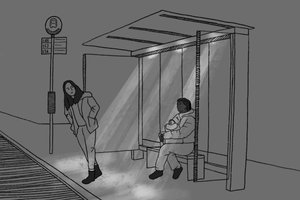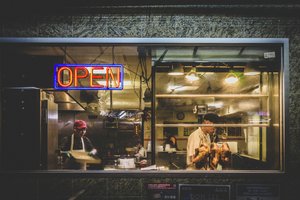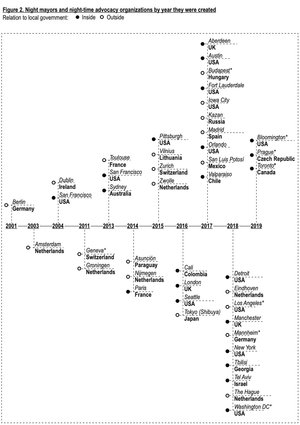Notes on Nighttime Governance
While New York City is often regarded as the “city that never sleeps,” most of our policy and planning contemplates only what happens during the day—so what about the night?

For those of us working the average 9–5 job, the inconveniences of late night transit disruptions, and lack of available food offerings (aside from the bodega) are infrequent occurrences that are mostly accepted as the cost of being out late. If we’re worried about getting home safe after a night of dancing, we can easily justify splurging on a cab for example. But for those whose days start as ours end, navigating these hurdles on a nightly basis becomes a significant challenge. Much of what happens at night, while less exciting than the club, is nonetheless highly essential: deliveries to stores to replenish stock, building staff cleaning offices, hospital workers caring for patients and attending to emergencies. Nighttime activities help feed the energy of the city, and maintain and support much of what happens during the day. Which begs the question, in a city that has a lot of the infrastructure needed to support its night time workers, why do we opt not to?
The refrain that the pandemic has brought many underlying issues to the surface rings loudest when considering how the city functions at night. Apart from shutting down entire industries (nightlife) and severely impacting others (restaurants), many policy decisions made during the height of the COVID emergency measures negatively impacted those working at night.
When subway service was reduced in 2020—no longer running 24 hours a day—essential workers traveling at night faced the added challenge of longer commutes and were forced to use less-reliable bus service. This created additional safety risks for already vulnerable workers. Many night time workers who were left unemployed were classified as “gig workers”– or independent contractors that are paid by the shift — and therefore were not immediately eligible for financial relief during the pandemic. DJs, dancers, sound and lighting engineers were some of the workers that faced difficulty in obtaining unemployment benefits and were able to receive Pandemic Unemployment Insurance through federal legislation passed in late March 2020. Undocumented workers, many of whom work in industries greatly impacted by the pandemic and also often worked at night, were not eligible for unemployment benefits. New York State created the largest fund to assist undocumented workers in early 2021, but the $2.1 Billion allocated for the fund was quickly depleted, and never replenished in this year’s budget .
Even measures to curb the transmission of COVID-19 such as testing and vaccinations were not readily available to those working non-traditional hours, unless they sacrificed work hours or sleep to access these resources.

Nighttime Governance and policy is slowly gaining traction globally as there is a shift in how people work and enjoy cities, with more activity taking place at night. As nighttime activities resume and policymakers and elected officials work out recovery measures, it is important to consider those working non-traditional hours and those enjoying New York City at night. In 2018, New York City passed legislation which created the Office of Nightlife. The office, with the accompanying Nightlife Advisory Board, has made recommendations and implemented measures to assist businesses that are navigating the challenges of running a nightlife business in New York City. However, there is much work to be done to address the needs of workers in this industry, as well as those who work at night in general, as their challenges are very similar. These workers lack access to resources and benefits most of us take for granted such as reliable transportation, active streets that contribute to public safety, and the ability to visit government offices and other businesses for services.

As we move intentionally towards creating a more resilient city, we need to consider how our current and future policy impacts the lives of those who keep the city running both in the day and the night.
Brittany Kriegstein and Leonard Greene, “Delivery man fatally shot while waiting on a bus. Family says he’d be alive if NYC subways were running overnight.” New York Daily News. May 26, 2020. https://www.nydailynews.com/new-york/ny-manhattan-shooting-subway-shutdown-20200526-f3vhzizr2fdyhjwqhpc2fuvply-story.html
A. Seijas & M.M. Gelders, “Governing the night-time city: The rise of night mayors as a new form of urban governance after dark.” Urban Studies 58 (2020): 316 - 334.
John Campbell, “NY lawmakers pass $220B budget that changes bail reform, approves Buffalo Bills stadium funding.” Gothamist. April 9, 2022. https://gothamist.com/news/ny-lawmakers-pass-220b-budget-that-changes-bail-reform-approves-buffalo-bills-stadium-funding